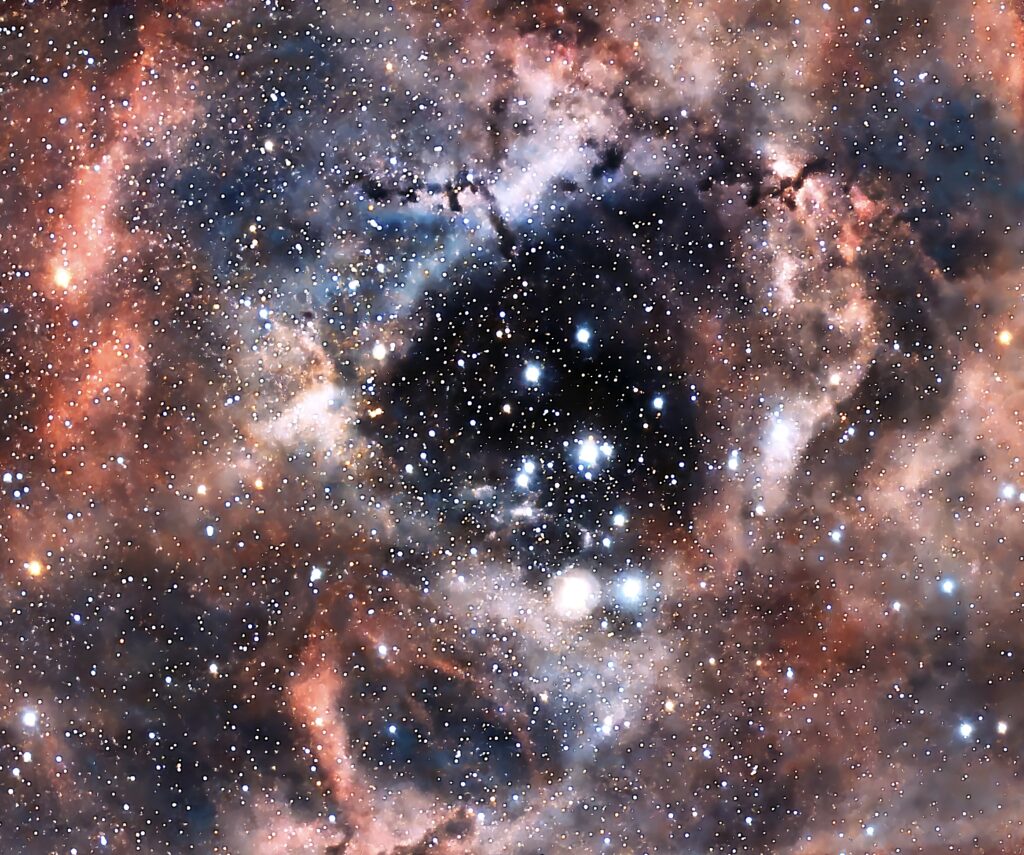
The Rosette Nebula, Sixty Minute Celestron Origin Image (c) DEWolf 2025.
Today let’s talk about another rose nebula, this one with “bam!” One of the most spectacular sights in the night sky is the Rosette Nebula. Known for its striking beauty and its role as a stellar nursery, this giant cloud of gas and dust captivates astronomers and stargazers alike. The
Rosette Nebula is a large star-forming region located in the constellation Monoceros, about 4,500 light-years away from Earth. It spans about 50 light-years in diameter and is home to a young, open star cluster called NGC 2244, whose stars are just a few million years old. These stars have formed from the gas and dust that make up the nebula.
The nebula’s name, like that of Caroline’s Rose comes from its resemblance to a rose or in this case a rosette, a flower-like shape formed by the nebula’s intricate arrangement of gas clouds. The glowing gas and dust are illuminated by the bright, young stars at the heart of the nebula, giving it the appearance of a cosmic bloom.
At its core, the Rosette Nebula is a stellar nursery, a place where new stars are being born. The intense ultraviolet light from the newly-formed stars heats the surrounding gas and dust, causing the nebula to shine. In some parts of the nebula, the gas is dense enough to collapse under its own gravity, triggering the birth of new stars.
The most massive stars in the nebula have short lifespans and are known to have significant impacts on their environments. These stars emit powerful stellar winds, which can blow away the surrounding gas and dust, creating gaps and holes in the nebula. These energetic winds, combined with the ultraviolet radiation, shape the nebula into the stunning structure we observe today.
At the center of the Rosette Nebula lies NGC 2244, an open star cluster of around 2,000 young stars. These stars formed from the gas and dust that surrounds them, and their bright ultraviolet radiation and strong stellar winds have shaped the nebula into its current form. NGC 2244 is a relatively young cluster, only about 4 to 5 million years old, which is just a blink in the timeline of the universe.
The stars in this cluster are responsible for much of the nebula’s bright, glowing appearance. The cluster itself is held together by gravity, but over time, the stars will drift apart as they age, and the nebula disperses into space.
The Rosette Nebula is composed of both emission nebulae and dark nebulae. The emission nebulae are the parts of the nebula that glow brightly due to ionized gas being energized by the ultraviolet radiation from nearby stars. The most prominent part of the nebula is a vast region of ionized hydrogen gas, known as H II regions. These glowing hydrogen regions make up the majority of the nebula’s brightness.
On the other hand, dark nebulae are dense regions of gas and dust that block the light from stars and other bright nebulae behind them. These dark patches form a striking contrast against the brighter areas of the nebula, adding depth and complexity to the structure.
The image of Figure 1 was taken with my Celestron Origin and is a sixty min exposure composed of 360 ten second frames. You need that to grow the image from a faint cloud with little detail to the relatively high signal to noise image of Figure 1. More on Signal to Noise at a later date, but let’s just say it is key to good astrophotographs.
People always ask me about the color. There is not much monkeying going on with that, just histogram equalization and then a tad of improved color saturation. This is the same as that I do with my bird photographs. More on that subject as well is to come.
I just do want to pose the question. With all this bam is it still sublime? I think that the answer is yes!
